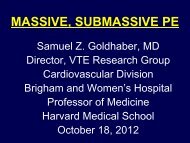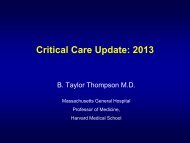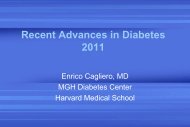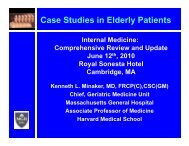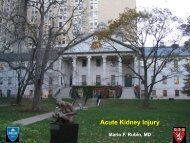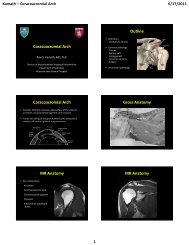Update on Non-Alcoholic Fatty Liver Disease
Update on Non-Alcoholic Fatty Liver Disease
Update on Non-Alcoholic Fatty Liver Disease
You also want an ePaper? Increase the reach of your titles
YUMPU automatically turns print PDFs into web optimized ePapers that Google loves.
<str<strong>on</strong>g>Update</str<strong>on</strong>g> <strong>on</strong> N<strong>on</strong>-<strong>Alcoholic</strong> <strong>Fatty</strong><br />
<strong>Liver</strong> <strong>Disease</strong><br />
Kathleen E Corey, MD, MPH<br />
Gastrointestinal Unit, MGH
Outline<br />
What are steatosis and NASH<br />
Why should you care about NASH<br />
How is NASH diagnosed<br />
Treating NASH
Case Presentati<strong>on</strong><br />
• AM is a 63M with obesity and hyperlipidemia<br />
who presents for evaluati<strong>on</strong> of abnormal LFTs.<br />
• AST 57, ALT 52, AP 80, TB 0.4<br />
• No history of alcohol use, no risk factors for viral<br />
hepatitis
Case Presentati<strong>on</strong><br />
• Viral serologies, ir<strong>on</strong> studies, AIAT, celiac<br />
studies, TSH normal<br />
• ANA positive at 1:40, ASMA positive at<br />
1:80<br />
• US shows fatty infiltrati<strong>on</strong>, no ascites,<br />
splenomegaly or abdominal varices
Case Presentati<strong>on</strong>: What is<br />
the diagnosis<br />
• Autoimmune hepatitis<br />
• Viral hepatitis<br />
• NAFLD<br />
• Celiac disease
What is the next step<br />
• Weight loss and exercise<br />
• Watchful waiting – repeat LFTs in 1 year<br />
• Start Vitamin E<br />
• <strong>Liver</strong> Biopsy
Case Presentati<strong>on</strong><br />
• <strong>Liver</strong> biopsy<br />
– 33-66% steatosis<br />
– Diffuse lobular<br />
inflammati<strong>on</strong> with<br />
glycogenated nuclei<br />
– Hepatocyte ballo<strong>on</strong>ing<br />
– Fibrosis stage 4 of 4<br />
c/w cirrhosis
NAFLD<br />
Spectrum of Hepatic Pathology<br />
Steatohepatitis<br />
Steatosis<br />
Cirrhosis<br />
Hepatocellula<br />
r carcinoma
N<strong>on</strong>-<strong>Alcoholic</strong> <strong>Fatty</strong> <strong>Liver</strong> (NAFL)<br />
Steatosis<br />
<strong>Fatty</strong> hepatocytes<br />
Intracellular<br />
fat depositi<strong>on</strong>
N<strong>on</strong>-<strong>Alcoholic</strong> SteatoHepatitis<br />
(NASH)<br />
Intracellular<br />
fat depositi<strong>on</strong><br />
Necrosis<br />
Fibrosis<br />
Fat deposits<br />
Inflammati<strong>on</strong><br />
Fibrosis with necrosis
Cirrhosis<br />
Regenerati<br />
ve nodule<br />
Fibrosis<br />
Nodules<br />
surrounded by<br />
fibrosis
How Many Americans Have<br />
NAFLD<br />
• 10%<br />
• 25%<br />
• 40%<br />
• 60%<br />
• 75%
Impact of NAFLD<br />
Wanless IR Hepatology 1990<br />
Thursz. EASL Berlin 2011
NAFLD Prevalence Dallas<br />
Heart Study<br />
(~1100 African Americans, 700 Caucasians, 400 Hispanics)<br />
No risk factors<br />
(n = 375)<br />
Assess risk factors<br />
for fatty liver<br />
H 1 -NMR spectroscopy<br />
Define normal<br />
liver fat c<strong>on</strong>tent<br />
Assess prevalence of increased liver fat (steatosis)<br />
in entire populati<strong>on</strong> & ethnic subgroups
Dallas Heart Study Results<br />
<strong>Liver</strong> fat<br />
< 5.5%<br />
<strong>Liver</strong> fat<br />
> 5.5%<br />
Steatosis = 31%<br />
<strong>Liver</strong> enzymes NORMAL in most (79%) with steatosis
Prevalence of Hepatic Steatosis: Varies with Ethnicity<br />
Prevalence of Hepatic Steatosis<br />
Varies with Ethnicity<br />
<strong>Fatty</strong> liver<br />
45%<br />
33%<br />
24%<br />
Hispanics Whites Blacks
NAFLD in High-Risk Populati<strong>on</strong>s: Type 2 Diabetes Mellitus<br />
NAFLD in High-Risk Populati<strong>on</strong>s<br />
Type 2 Diabetes Mellitus<br />
• 50% prevalence <strong>on</strong> ultrasound<br />
•NASH unusually comm<strong>on</strong><br />
• Steatosis: 12%<br />
• NASH: 87%<br />
•Fibrosis or cirrhosis documented in 20%<br />
Gupter et al. J Gastro Hepatol 2004;19:854-859<br />
Tolman et al. Ann Intern Med 2004; 141:946-956
What percentage of NASH<br />
patients have cirrhosis<br />
• 1.5%<br />
• 3%<br />
• 20%<br />
• 33%<br />
• 55%
Neuschwander-Tetri Hepatology 2010<br />
Impact of NAFLD<br />
• Cirrhosis complicates 1% of patients with<br />
steatosis, up to 33% of NASH<br />
• NASH is associated with increased risk of<br />
HCC<br />
• NASH cirrhosis will be the leading<br />
indicati<strong>on</strong> for OLT by 2020<br />
Dam-Larsen Gut 2007
Prognostic Implicati<strong>on</strong>s<br />
of NASH + Fibrosis<br />
• More c<strong>on</strong>sistent and rapid progressi<strong>on</strong><br />
to cirrhosis than NASH al<strong>on</strong>e<br />
NASH<br />
> 10 years<br />
Cirrhosis<br />
3%<br />
NASH +<br />
fibrosis<br />
5-10 years<br />
Cirrhosis<br />
35%<br />
Matte<strong>on</strong>i Gastroenterology 1999
Impact of NAFLD<br />
• NAFLD is associated with an increased all<br />
cause mortality<br />
• NAFLD is associated with increased risk of<br />
cardiovascular disease in diabetic and<br />
n<strong>on</strong>-diabetic patients<br />
Tarher Diabetes Care 2007<br />
Ekstedt M Hepatolgy 2006
Diagnostic Goals<br />
• Goal #1: Determine the etiology of liver<br />
disease as NAFLD<br />
• Goal #2: Determine the type of NAFLD<br />
• Goal #3: Determine the severity of<br />
NAFLD
Goal #1: Determine the<br />
Etiology<br />
• Who might have NAFLD<br />
– Any<strong>on</strong>e with an elevated AST or ALT<br />
– Any<strong>on</strong>e with the Metabolic Syndrome<br />
– Any<strong>on</strong>e with fatty liver <strong>on</strong> imaging<br />
– Any<strong>on</strong>e with cryptogenic cirrhosis
Goal #1: Determine the<br />
Etiology<br />
• Exclude other causes of abnormal LFTs<br />
– Alcohol use<br />
– Viral hepatitis<br />
– Autoimmune liver disease (PBC, PSC, AIH)<br />
– Celiac disease<br />
– Thyroid disease<br />
– Ir<strong>on</strong> depositi<strong>on</strong> disease<br />
• Evaluate for presence of metabolic<br />
syndrome
Goal #1: Determine the<br />
Etiology<br />
• AST and ALT
Goal #1Determine the<br />
Etiology<br />
• Imaging for NAFLD<br />
– US, MRI and CT can<br />
assess for fat<br />
– Other liver disease<br />
can cause steatosis<br />
– Absence of fat does<br />
not exclude NAFLD<br />
especially in setting of<br />
advanced fibrosis
Goal #1: Determine the<br />
Etiology<br />
• Distinguish <strong>Alcoholic</strong> <strong>Liver</strong> <strong>Disease</strong> from<br />
NAFLD<br />
– NAFLD Implies no EtOH or “safe” EtOH levels<br />
– 2 drink or less per day for women, 3 drinks or<br />
less per day for men<br />
– This is a recent increase in allowable alcohol<br />
use from the AASLD<br />
Chalasani et al Hepatology 2012
Sec<strong>on</strong>dary Causes of<br />
NAFLD<br />
• Hepatitis C<br />
• Wils<strong>on</strong>s <strong>Disease</strong><br />
• Disorders of lipid<br />
metabolism<br />
– Abetalipoproteinemia<br />
– Hypobetalipoproteinemia<br />
– Andersen’s disease<br />
– Weber-Christian syndrome<br />
• Total parenteral nutriti<strong>on</strong><br />
• Severe weight loss<br />
• Celiac disease<br />
• Medicati<strong>on</strong>s<br />
– Amiodar<strong>on</strong>e<br />
– Diltiazem<br />
– Tamoxifen<br />
– Steroids<br />
– Highly active antiretroviral<br />
therapy
Goal #2: Determine the<br />
Type of NAFLD<br />
• <strong>Liver</strong> functi<strong>on</strong> tests are insufficient to distinguish<br />
steatosis and NASH<br />
• In a cohort of diabetics 86% of both steatosis and NASH had normal<br />
LFTs<br />
• ALT is not a reliable marker to differentiate steatosis from NASH<br />
Tarher Diabetes Care 2007
Goal #2: Determine the Type<br />
of NAFLD<br />
• Metabolic syndrome is associated with increased risk of<br />
NASH<br />
• Elevated Ferritin level suggests increased risk for NASH<br />
• Biopsy is the <strong>on</strong>ly definitive way to differentiate steatosis<br />
and NASH<br />
Tarher Diabetes Care 2007
Goal #3: Determine the<br />
Severity of <strong>Disease</strong><br />
• Goal is to identify patients with advanced<br />
fibrosis or cirrhosis<br />
• The absence of signs of cirrhosis of<br />
physical exam, labs suggesting synthetic<br />
dysfuncti<strong>on</strong> or PHTN or imaging<br />
suggesting cirrhosis are not sufficient to<br />
exclude cirrhosis<br />
• <strong>Liver</strong> biopsy is needed
Goal #3: Determine the Severity<br />
of <strong>Disease</strong><br />
• Risk Factors for Cirrhosis<br />
• Age > 45-50 years<br />
• Obesity<br />
• Diabetes<br />
• 66% prevalence of bridging fibrosis if<br />
age > 50 years and patient obese or<br />
diabetic<br />
• NAFLD fibrosis score
<strong>Liver</strong> Biopsy<br />
<strong>Liver</strong> Biopsy
Risks of <strong>Liver</strong> Biopsy<br />
• Post-procedure RUQ pain<br />
• Bleeding<br />
• Organ perforati<strong>on</strong><br />
• Bile perit<strong>on</strong>itis
• NASH<br />
– Fat<br />
Is there NASH <strong>on</strong> <strong>Liver</strong><br />
– Lobular<br />
inflammati<strong>on</strong><br />
– Ballo<strong>on</strong>ing<br />
degenerati<strong>on</strong><br />
• Fibrosis<br />
– Stage 3 or 4 (out of<br />
4) is advanced<br />
fibrosis = cirrhosis<br />
Biopsy
Weight Loss & Exercise are<br />
Cornerst<strong>on</strong>es of Therapy<br />
• Weight loss<br />
– 3-5% weight loss improves steatosis<br />
– 7-10 % weight loss has been associated with a significant<br />
reducti<strong>on</strong> in NAS<br />
• Weight loss surgery<br />
– 69% had complete resoluti<strong>on</strong> of NASH<br />
– 65% had partial or complete improvement in fibrosis<br />
• Exercise in absence of weight loss decreases steatosis<br />
Ekstedt J of Hepatology 2007 (statin)<br />
Mummadi CGH 2008<br />
Pomrat Hepatology 2010 (7%)
Pioglitaz<strong>on</strong>e Improves<br />
Inflammati<strong>on</strong> in NASH<br />
• Pioglitaz<strong>on</strong>e 30- 45mg daily for 48-96<br />
weeks<br />
• Necroinflammati<strong>on</strong> and steatosis improved<br />
c<strong>on</strong>siderable in pioglitaz<strong>on</strong>e group<br />
• No improvement in fibrosis seen<br />
Belfort NEJM 2006<br />
Sanyal NEJM 2010
Vitamin E Improves<br />
Steatosis & Inflammati<strong>on</strong><br />
• RTC of 247 patients with biopsy proven NASH<br />
without DM<br />
• Vitamin E 800 units daily<br />
• Vitamin E lobular inflammati<strong>on</strong> and steatosis<br />
• No change in fibrosis was seen<br />
Sanyal NEJM 2010
Vitamin E and Prostate<br />
Cancer<br />
• 35 533 men randomized to selenium, vitamin E or both<br />
agents, or both matched placebos for 7- 12 years.<br />
• Compared with placebo, the absolute increase in risk of<br />
prostate cancer per 1000 pers<strong>on</strong>- years was 1.6 for<br />
vitamin E, 0.8 for selenium, and 0.4 for the combinati<strong>on</strong>.<br />
• Use vitamin E with cauti<strong>on</strong> in men with NASH<br />
EA Klein et al., JAMA 2011
Pharmacotherapy Under<br />
Investigati<strong>on</strong><br />
• Alpha lipoic acid<br />
• Linagliptin<br />
• PUFA<br />
• ARB/ACEi<br />
• Metformin<br />
• OKT3<br />
• HMG CoA reductase<br />
inhibitors<br />
• Ezetimibe<br />
Basu AASLD 2011 #1658<br />
Takeshita AASLD 2011 #1599
Advanced Fibrosis - Refer<br />
to Hepatology<br />
• Advanced fibrosis = cirrhosis<br />
• Patients need<br />
– EGD for variceal screening<br />
– Q6m<strong>on</strong>ths US or MRI for HCC screening<br />
– MELD labs (INR, Cr, total bilirubin)<br />
– M<strong>on</strong>itoring for the complicati<strong>on</strong>s of advanced liver<br />
disease
Take Home Messages<br />
NASH is the form of NAFLD that can progress<br />
NASH leads to cirrhosis and HCC<br />
Biopsy is needed for<br />
NASH Diagnosis<br />
Weight loss and<br />
pharmacotherapy



